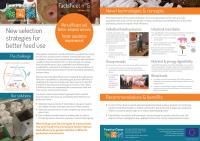Factsheet N°5 New selection strategies for better feed use
 The challenge
The challenge
Monogastric animals are usually selected as purebred lines using records from nucleus farms, whereas commercial farms raise crossbreds. Nucleus farms provide better sanitary and nutritional conditions than production farms so that animals can express their best performance. Also, purebreds have different gene combinations compared to crossbreds. As a result, predictions in commercial farms always deviate from the standards obtained in nucleus farms.
Directly improving feed efficiency of crossbreds through genetic selection of purebreds is a promising goal, but feed efficiency is challenging to measure in production farms due to the specific and often costly resources necessary to record it. This makes it difficult to select for crossbreds that consume less feed and have a lower environmental impact.
Our solutions
The Feed-a-Gene project tested approaches that could be used to improve the accuracy of selecting feed efficiency for production farms:
- Individual measurements of feed intake in groups of poultry and rabbits through automated devices or video cameras.
- Individual measurements of body samples (e.g. feces, blood, saliva, hair).
- New statistical models based on existing data to capture timeline dynamics, dynamics of groups, and trait heterogenity.
After testing more than ten types of measurement, five were found to be promising to further improve feed efficiency by genetic selection in different production environments.